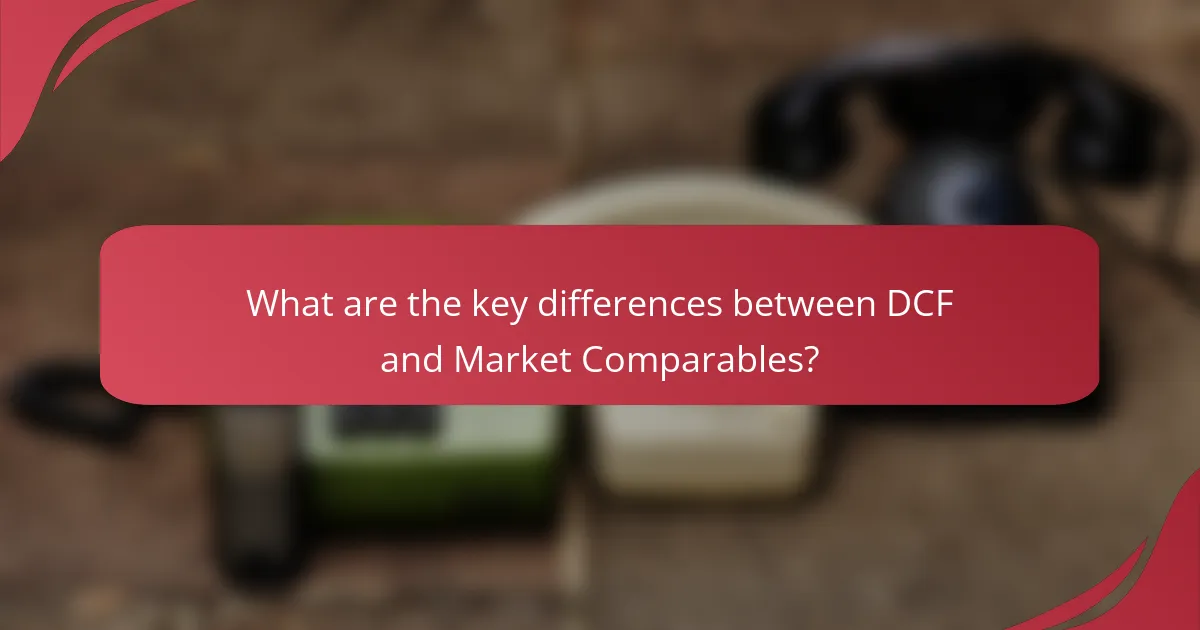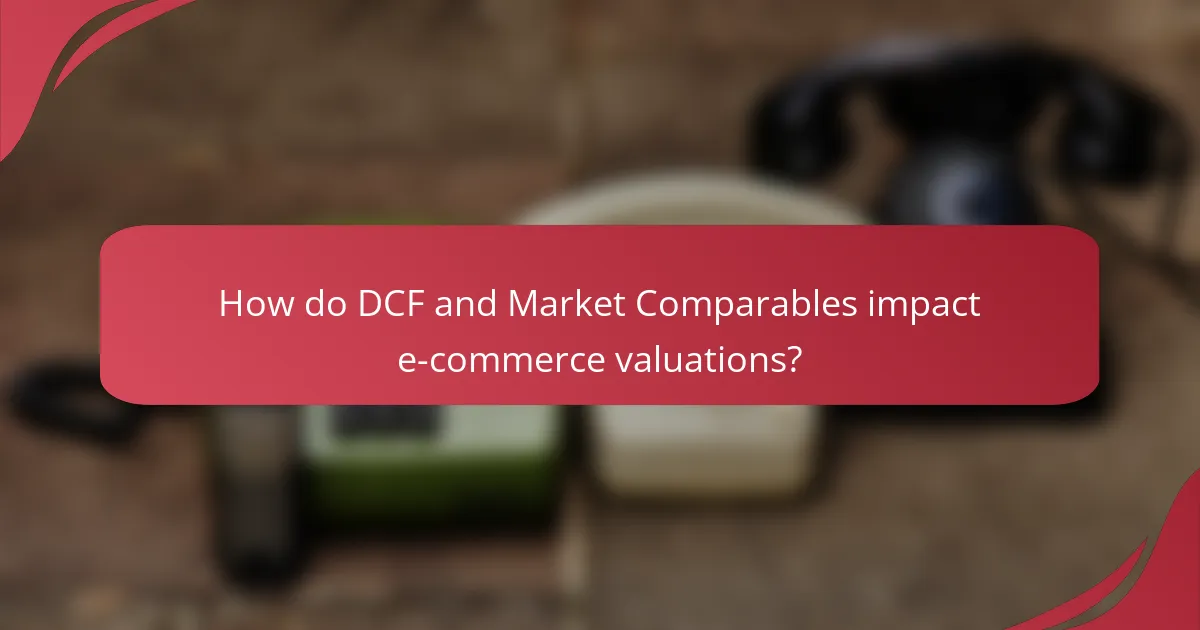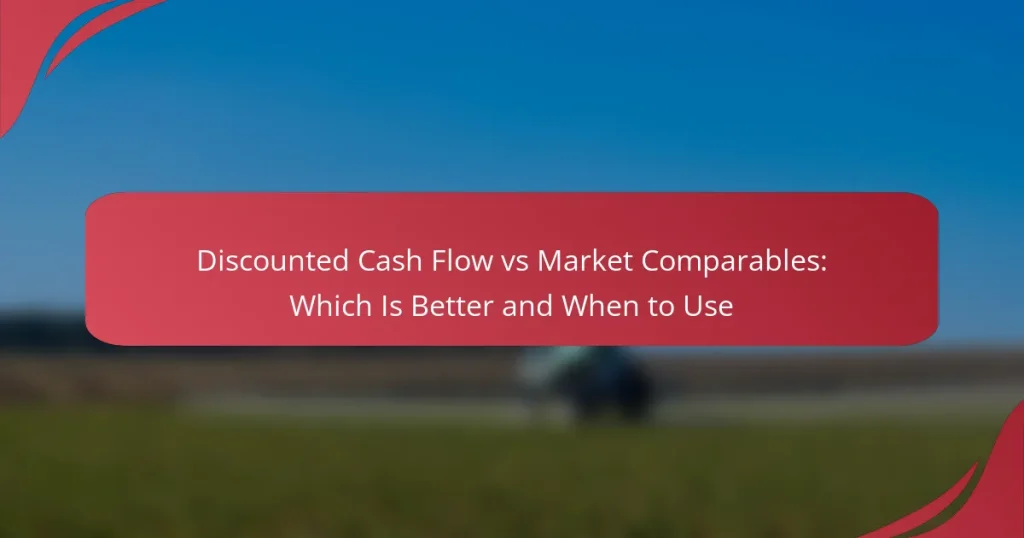When evaluating investment opportunities, choosing between Discounted Cash Flow (DCF) and Market Comparables is crucial. DCF is ideal for determining the intrinsic value of long-term investments through projected cash flows, while Market Comparables offer a quicker valuation method by analyzing similar companies in the market. Understanding the strengths and appropriate contexts for each approach can significantly enhance investment decision-making.

When should I use Discounted Cash Flow?
Discounted Cash Flow (DCF) is best used when you need to assess the intrinsic value of an investment based on its expected future cash flows. This method is particularly effective for long-term investments and situations where cash flows can be reliably estimated.
Long-term investment analysis
DCF is ideal for analyzing long-term investments because it focuses on the present value of future cash flows. Investors can project cash flows over several years, discounting them back to their present value using a suitable discount rate. This approach helps in understanding whether an investment will yield satisfactory returns over time.
For instance, if a company is expected to generate increasing cash flows over the next five to ten years, a DCF analysis can reveal its potential value compared to its current market price.
Valuation of startups
Startups often lack historical data, making traditional valuation methods challenging. DCF can be beneficial here, as it allows investors to base valuations on projected cash flows rather than past performance. However, the accuracy of these projections is crucial; overly optimistic forecasts can lead to inflated valuations.
When valuing a startup, consider using a range of scenarios (best case, worst case, and most likely) to account for uncertainty in cash flow predictions. This can provide a more balanced view of the startup’s potential value.
Cash flow predictability
Using DCF is most effective when cash flows are predictable and stable. Industries with consistent revenue streams, such as utilities or established consumer goods, are well-suited for this analysis. In contrast, sectors with volatile cash flows may lead to unreliable DCF results.
To enhance predictability, analyze historical cash flow trends and consider external factors that may impact future performance. This diligence can help refine your discount rate and improve the accuracy of your DCF analysis.

When should I use Market Comparables?
Market comparables should be used when you need a quick and straightforward method to assess the value of a company based on similar entities in the market. This approach is particularly effective in industries with many comparable firms, allowing for a relative valuation based on market data.
Quick valuation assessments
Market comparables offer a rapid way to estimate a company’s value by analyzing the financial metrics of similar businesses. This method is useful when time is limited or when a rough valuation is sufficient for decision-making. For instance, if you need to value a tech startup, you can quickly look at the valuations of comparable startups to gauge a reasonable range.
Established company comparisons
Using market comparables is ideal when evaluating established companies with a clear set of peers. By comparing metrics such as price-to-earnings (P/E) ratios or enterprise value-to-EBITDA ratios, you can gain insights into how the market values similar firms. This method works best in stable industries where companies have similar growth prospects and risk profiles.
Market trend analysis
Market comparables can help identify trends within specific sectors by analyzing how similar companies are valued over time. For example, if you notice a rising trend in the valuation multiples of companies in the renewable energy sector, it may indicate growing investor confidence and potential for future growth. Keeping an eye on these trends can inform strategic decisions and investment opportunities.

What are the key differences between DCF and Market Comparables?
The key differences between Discounted Cash Flow (DCF) and Market Comparables lie in their methodologies and data requirements. DCF focuses on estimating the present value of future cash flows, while Market Comparables assess value based on similar entities in the market.
Methodology differences
The DCF method calculates a company’s value by projecting its future cash flows and discounting them back to their present value using a discount rate. This approach requires a deep understanding of the business’s operations and future potential.
In contrast, Market Comparables evaluate a company’s worth by comparing it to similar businesses that have recently been sold or are publicly traded. This method relies on market data and is generally quicker to implement, but it may not capture unique aspects of a business that could affect its valuation.
Data requirements
DCF analysis requires detailed financial projections, including revenue forecasts, operating expenses, and capital expenditures. It also necessitates determining an appropriate discount rate, which can be subjective and varies based on risk factors.
Market Comparables, however, primarily depend on external market data, such as price-to-earnings ratios or enterprise value-to-EBITDA multiples from comparable companies. This method requires less internal data but relies heavily on the availability and accuracy of market information.
Risk assessment approaches
In DCF, risk is assessed through the discount rate, which reflects the expected return required by investors given the business’s risk profile. A higher perceived risk leads to a higher discount rate, which can significantly lower the present value of future cash flows.
Market Comparables assess risk indirectly through the multiples derived from comparable companies. If similar companies are trading at lower multiples due to market conditions or sector-specific risks, this can influence the valuation of the target company. Understanding these dynamics is crucial for accurate assessments.

How do DCF and Market Comparables impact e-commerce valuations?
Discounted Cash Flow (DCF) and Market Comparables are two critical methods for evaluating e-commerce businesses. DCF focuses on future cash flows, while Market Comparables assess value based on similar companies’ performance.
Revenue projections
Revenue projections are essential in DCF analysis as they estimate future cash flows based on expected sales growth. Accurate forecasting can depend on market trends, historical performance, and economic conditions. For instance, e-commerce companies often experience growth rates ranging from low double digits to over 30% annually, depending on the sector.
In contrast, Market Comparables rely on current revenue figures from similar businesses to establish valuation benchmarks. This method often uses multiples like Price-to-Earnings (P/E) or Price-to-Sales (P/S) ratios, which can vary significantly based on the competitive landscape.
Market positioning
Market positioning plays a crucial role in both valuation methods. In DCF, a company’s competitive advantage can enhance revenue projections, impacting overall valuation. E-commerce firms with strong brand recognition or unique offerings may justify higher growth rates in their forecasts.
For Market Comparables, positioning determines how a company stacks up against its peers. Companies in niche markets or with innovative business models may command higher valuation multiples, reflecting their perceived growth potential and market share.
Investment attractiveness
Investment attractiveness is influenced by the perceived risk and return associated with each valuation method. DCF can provide a detailed view of long-term potential, appealing to investors focused on sustainability and cash flow generation. However, it requires accurate assumptions, which can be a risk if market conditions change.
Market Comparables offer a quicker assessment of value, making them attractive for investors seeking immediate insights. However, they can overlook unique aspects of a business, leading to potential undervaluation. Balancing both methods can provide a more comprehensive view of an e-commerce company’s worth.

What are the advantages of using DCF?
The Discounted Cash Flow (DCF) method offers several advantages, particularly in assessing the intrinsic value of an investment. It allows for a detailed analysis of future cash flows, providing a clearer picture of an asset’s potential worth over time.
Focus on intrinsic value
The DCF approach emphasizes intrinsic value by estimating the present value of expected future cash flows. This method is particularly useful for investments where market prices may not reflect true worth, such as in the case of startups or unique assets. By concentrating on cash generation rather than market sentiment, investors can make more informed decisions.
Flexibility in assumptions
DCF models allow for flexibility in assumptions regarding growth rates, discount rates, and cash flow projections. Investors can tailor these inputs based on their insights or market conditions, which can lead to more accurate valuations. However, it’s crucial to ensure that assumptions are realistic to avoid overestimating value.
Long-term perspective
Using DCF encourages a long-term perspective by focusing on cash flows that extend well into the future. This is particularly beneficial for investments in industries with long development cycles, such as technology or pharmaceuticals. By evaluating long-term potential rather than short-term fluctuations, investors can better align their strategies with sustainable growth.


